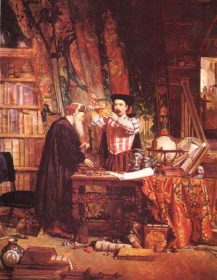The last few decades have seen the growth of a vigorous research program investigating alchemy and a subsequent increase in our understanding of how it functioned both in late antiquity and early Europe. The ultimate origins of alchemy, however, are still obscure. Different scholars place its genesis either in Egypt, India, or China. In fact, the difficulties posed by a historical field of study that spans three continents and nearly two millennia are increasingly leading students to speak in terms of “alchemies” rather than seeing the movement in unified or totalizing terms.
Two basic goals, common to many historical schools of alchemy, were the creation of a universal medicine, capable of curing disease and extending life, and the mastery of the art of transmutation. The technical body of knowledge that supported these aims apparently arose out of the workshops of Egypt between 500 BCE and 200 CE. An investigation of period sources, such as the Leyden Papyrus X and the Stockholm Papyrus, show that Egyptian artisans and jewelers had become skilled at making glass, artificial gems, pigments, and even being able to change the properties of gold or other metals through using chemical dyes or alloys.
 Nevertheless, true alchemy did not emerge until the third and fourth centuries of the current era, when these technical procedures were combined with Greek thought and philosophy. Authors such as pseudo- Democritus, Zosimos, and Stenphanos of Alexandria sought to integrate this body of art with both classic philosophical texts and more contemporary Hellenistic movements like Neoplatonism and Gnosticism. It was only after these associations were made that the phenomenon known as alchemy can be said to have existed. Interest in the subject was maintained and advanced by Arab scholars after the seventh century. Like many other forms of knowledge, they were primarily responsible for importing it into Europe through works by authors like Jabir Ibn Hayyan, pseudo-Gerber, and Avincenna in the late 12th and 13th centuries.
Nevertheless, true alchemy did not emerge until the third and fourth centuries of the current era, when these technical procedures were combined with Greek thought and philosophy. Authors such as pseudo- Democritus, Zosimos, and Stenphanos of Alexandria sought to integrate this body of art with both classic philosophical texts and more contemporary Hellenistic movements like Neoplatonism and Gnosticism. It was only after these associations were made that the phenomenon known as alchemy can be said to have existed. Interest in the subject was maintained and advanced by Arab scholars after the seventh century. Like many other forms of knowledge, they were primarily responsible for importing it into Europe through works by authors like Jabir Ibn Hayyan, pseudo-Gerber, and Avincenna in the late 12th and 13th centuries.
Interest in alchemy started to wane rapidly in Europe after the early 17th century as new theories of matter and chemistry emerged. Little notice was taken of this subject until the 19th century. Due to the Romantic movement, popular interest in alchemy increased, and it became associated with magic and astrology, which were also very much in vogue at the time. These 19th-century interpreters of alchemy sought to preserve the art by transforming it from a mode of inquiry about the natural world into an esoteric spiritual practice. This move was erroneously accepted by later scholars who were primarily interested in the perceived psychological or mystic nature of alchemical symbols, rather than their ability to convey technical knowledge. Perhaps the two most well-known authors using alchemy in this way were Mircea Eliade and Carl Jung. While their work made important contributions to the fields of psychology and comparative religion, their portrayal of the underlying subject matter was flawed. Recently, historians have become sensitive to these issues and are attempting to restore our understanding of this important phenomenon to its proper context.
References:
- Eliade, M. (1979). The forge and the crucible: The origins and structure of alchemy. Chicago: University of Chicago Press.
- Jung, C. C. (1970). Mysterium coniunctionis: An inquiry into the separation and synthesis of psychic opposites in alchemy. The Collected Works ofC. G. Jung (Vol. 14). Princeton: Princeton University Press.
- Klossowski De Rola, S. (1997). The golden game: Alchemical engravings of the seventeenth century. New York: Thames & Hudson.
- Linden, S. J. (2003). The alchemy reader: From Hermes Trismegistus to Isaac Newton. New York: Cambridge University Press.
- Newman, W. R. (2004). Promethean ambitions: Alchemy and the quest to perfect nature. Chicago: University of Chicago Press.
- Principe, L. M., & Newman, W. R. (2001). Some problems with the historiography of alchemy. In A. Grafton & W. Newman (Eds.), Secrets of nature: Astrology and alchemy in early modern Europe. Cambridge: MIT Press.
Like? Share it!
